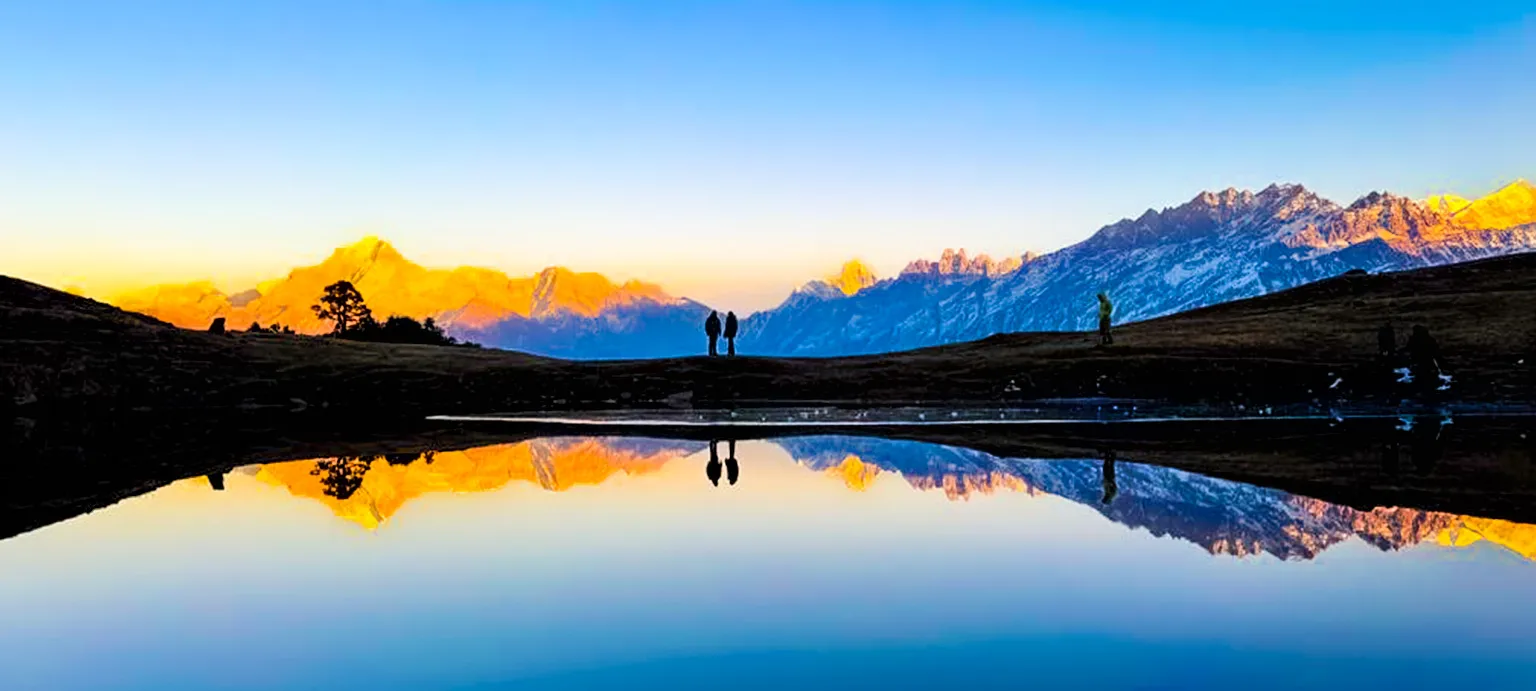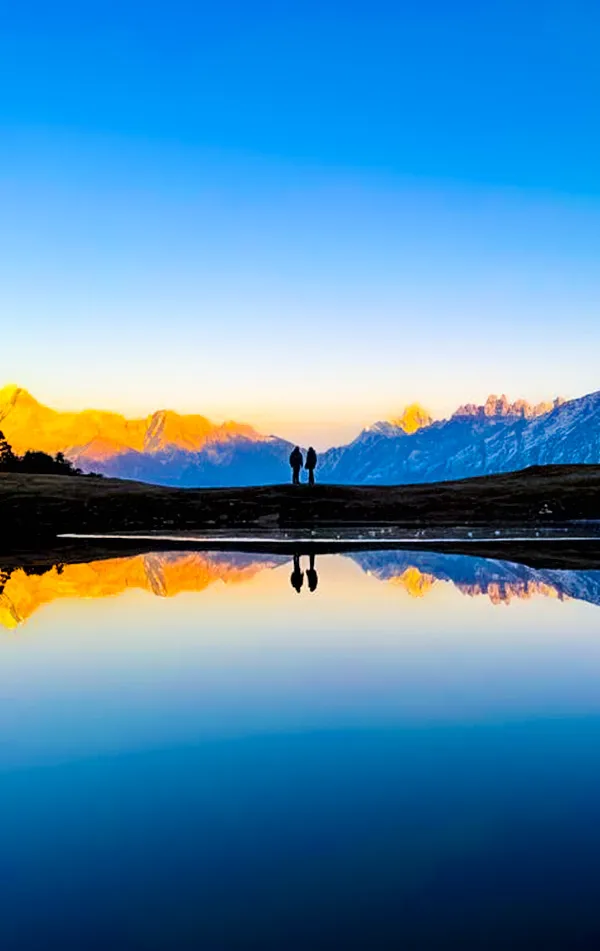
Region
Uttarakhand | India
Duration
6 Days
Max Altitude
12750 Ft.
Trekking Km
33 KM
Grade
Moderate
Help & Support
+91 7302321133 info@trekthehimalayas.com10:00 hrs to 18:00 hrs | GMT +5:30
Monday - Saturday | Sunday Closed
9500 /Person
- +5% GST (goods and services tax)
- Services Pipalkoti Pipalkoti
- Addons
-
Insurance is Mandatory.
-
Non-Indian rates are slightly higher. Trek coordinator will provide balance payment link post-booking.
- Get insurance through us or elsewhere. If not through us, email for a refund after booking.
-
Cancellation 4 or more days before the start of the trip results in a 100% cash refund.
-
Cancellation less than 4 days from the start of the trip results in no refund.
-
Transportation Rishikesh to Pipalkoti & retun is optional
-
Choose add-ons during booking. If missed, log in and add them later
-
Book transportation at least 10 days before the trek.
-
Cancellation 4 or more days before the start of the trip results in a 100% cash refund.
-
Cancellation less than 4 days from the start of the trip results in a 50% cash refund.
-
Cancellation after the trip date does not qualify for a refund.
-
Backpack offload is optional
-
Choose add-ons during booking. If missed, log in and add them later.
-
Book off-load at least 10 days before the trek.
-
For offline bookings at the base camp, a convenience fee of Rs. 1800 applies.
-
Cancellations made before the trip date will receive a full refund.
Insurance 210
Transport 1600
Offload 1200
For more information. Please complete this form.
Help & Support
+91 991 772 4737info@trekthehimalayas.com 10:00 hrs to 18:00 hrs | GMT +5:30
Monday - Saturday | Sunday Closed
Overview
Trek Name: Winter Kuari Pass Trek
Days: 6
Adventure Type: Trekking
Base Camp: Pipalkoti
Season:Spring | Winter |
Month:January | February | March | April | November | December |
Country: India
Altitude: 12750 Ft.
Grade: Moderate
Rail Head: Haridwar/Rishikesh is the nearest rail head to the base camp
Stay: Camping (Twin sharing) & Hotel/Guesthouse
Food: Meals while on trek & at Hotel/Guesthouse (Veg & Eggs)
Location: Uttarakhand
Distance: 33 Km.
Trail Type: Circle trail | Camping in various locations, starting and ending at the same point.
AirPort: Jolly Grant Airport, which is 28 km away from Dehradun
Highlights:
- +5% GST (goods and services tax)
- Services Pipalkoti Pipalkoti
The Winter Kuari Pass Trek is a mesmerizing high-altitude adventure in the Indian state of Uttarakhand. It is renowned for its breathtaking vistas of the Garhwal Himalayas, including the Nanda Devi, Dronagiri, and Kamet peaks. This winter trek offers a unique experience for trekkers, allowing you to explore the Himalayas in their snow-covered splendour. All along the trek mountain views keep you company as you immerse yourself in the wintry charm of the Himalayas. The best thing about this trek is that its moderate grade allows both seasoned trekkers as well as fit beginners to embark on the journey.
The Winter Kuari Pass Trek is an extraordinary journey that allows you to immerse yourself in the snowy beauty of the Himalayas. It combines the natural grandeur of the mountains, cultural immersion, and the thrill of high-altitude trekking, making it a memorable and transformative experience.
Highlights
The Breathtaking Views from Kuari Pass
The main attraction of the trek, of course, is standing atop Kuari Pass. From the pass, you get an unrivalled view of the Himalayan Ranges that encircle you all around. The Dronagiri Parvat is the most prominent along with Hathi and Gauri Parvat, Nanda Devi and several other Himalayan peaks.
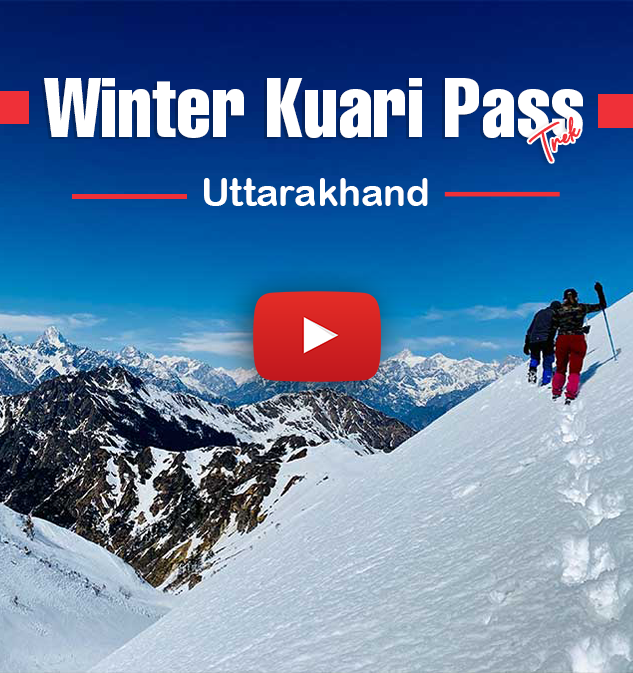
Who Can Participate
-
Age; 12 years +.
-
First timers can apply; previous trekking experience is more appreciated.
-
The climber must be fit and have sufficient stamina to cover 5 km of distance in 30 minutes without stress.
-
The climber should be able to carry a 10-15 kg backpack.
-
Pulse rate at rest must be in between (60 to 90 beats per minute)
-
Blood Pressure Reading must be in between (DIASTOLIC 70 – 90, SYSTOLIC 100 - 140 mm Hg)
-
Respiratory rate at rest must be in between (12 to 20 breaths per minute)
-
Should not have Liver and kidney issues
-
Should not have Diabetes Mellitus, Bronchial Asthma, Heart problems, Hypertension etc
-
No pacemaker implant
-
People with the Sinus issues, Epilepsy please contact to trek coordinator before booking the trek
-
If your BMI is not normal, Please contact our Trek coordinator before Trek booking.
Medical & Disclaimer Form (Mandatory Documents) Click here to download Medical & Disclaimer Form
- Government Employees can avail the benefit of Special Casual Leave (SCL) when you join us for a trekking expedition. As per the rules of the Pay Commission, Special Casual Leave can be availed for up to 30 days in a calendar year for trekking/mountaineering expeditions through a registered organization. Trek The Himalayas is a registered adventure tour operator by Indian Mountaineering Foundation (IMF) and Ministry Of Tourism (MOT)
- Trekkers have to apply for leave at least 20 days before trek departure date,
- This service is exclusive to Indian government employees and is applicable only for treks within India.
- Do mail at info@trekthehimalayas to apply and mention your booked trek date and trek name.
- Junior trekkers (below 15 years) should have a company of parents/guardians.
- Trekkers between 15 to 18 years can come solo with the disclaimer form signed by parent/guardian.
- Medical & Disclaimer Form (Mandatory Documents) Click here to download Medical & Disclaimer Form
Itinerary
Rishikesh to Pipalkoti
You will begin your journey with us from Rishikesh. Starting the drive from Rishikesh from the appointed pickup point (Rishikesh TTH office), we will take the fabled Badrinath Road.
If you are enthusiastic about cultural sightseeing and adventure water sports, you may like to arrange a brief stay at Rishikesh.
The 9 hour drive to Pipalkoti will surely be long and arduous, but you are never going to run out of mesmerizing views. The great river running with us on parallel will get wilder and more fascinating as we trudge uphill. We will be passing by the panchprayag or the five holy confluences of Ganga—Devaprayag, Rudraprayag, Karnaprayag, Nandaprayag, and Vishnuprayag.
So, keep your cameras on the ready and remain awake for most of the journey!
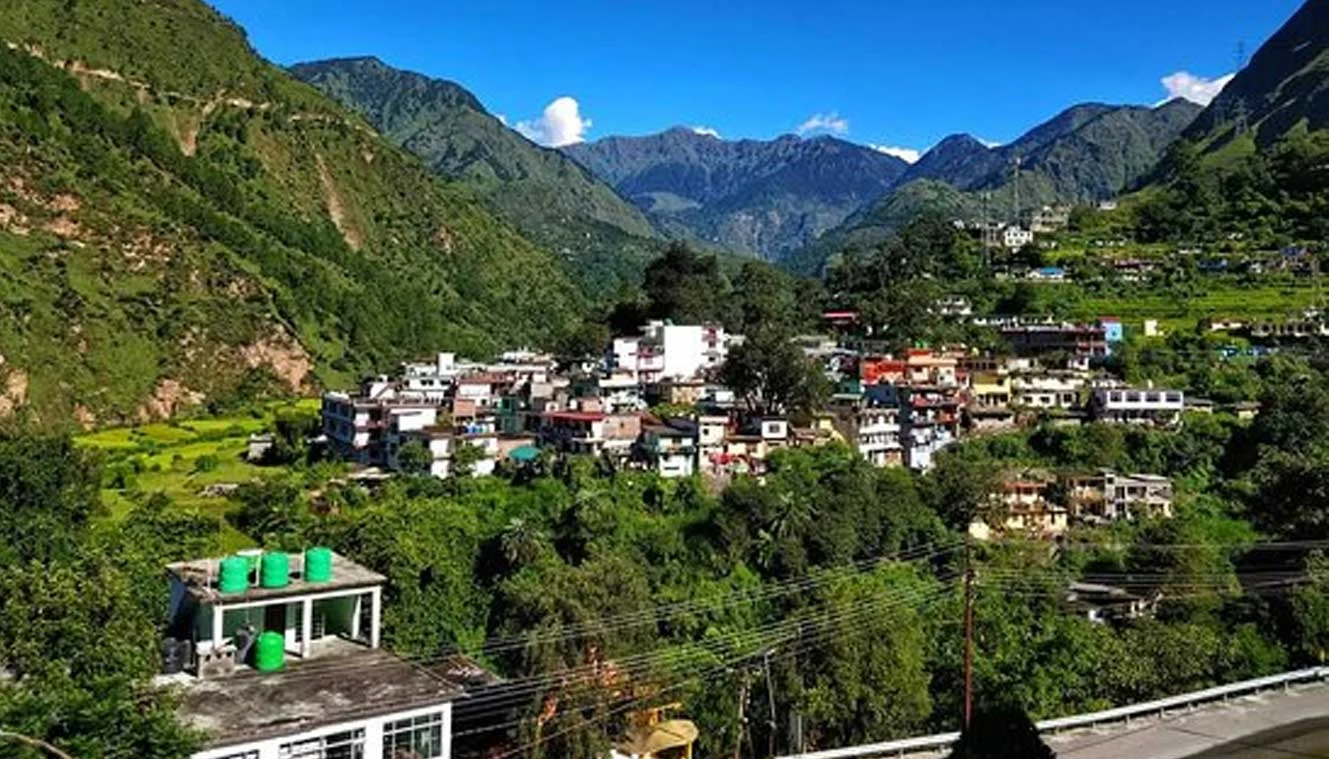
Pipalkoti – Gulling Top
A host of ice peaks will greet us at Joshimath. After an early breakfast on this day, we will head off to Dhak village in the Joshimath tehsil, a rocky drive of 1:45 minutes. From here our trek will commence. Look out for the gentle slopes of the Sleeping Lady Mountain of Joshimath on this drive. The gentle ups and downs of this mountain seem to form an outline of a lying lady.
The trek flags off from Dhak along a steady ascent. The dirt trail steers away from the main road and rises towards Tugasi village. There are a couple of sharp T-turns on this trail after which the walk takes place on a level ground followed by gradually ascending soft slopes. The terrain is mostly rough here. Leaving out the terrace farming lands, there is no affluence of greenery, but offers a sweeping view of the Garhwal frontier all around. Look out especially for the bright silvery sun-dazed stream of Dhauli-Ganga snaking it way in the abyss, and the Vishnugad-Tapovan Hydroelectric Power Station. You are not likely to find any snow in this zone.
Twenty to twenty-five minutes into the trek, you will be reaching village Kharchi, where you can fill your bottles and take some rest. The trail continues from the village on the same rocky path, keeping the valley to the left. The ascent id steep and encounters a couple of switchback turns, finally reaching the Lower Tugasi area. You can find the trail forking into two here and must take the one curving along a hydro run flour mill. Approximately 10 minutes from here you will reach the Upper Tugasi region, marked with a handful of wheat fields, flower beds, and thatched roofed huts. You can also find little streams coming down in this area.
Continue on this path, maintaining a steep climb, leaving the farmland behind and you will find the awe-inspiring sight of Dronagiri peak hauntingly rising at a distance. We will be pitching tents in the open meadows overlooking Dronagiri and fringed around with oak forests.
You can ask your trek leader to take you on an acclimatization walk to Gulling Top point this afternoon to enjoy the snow laden forests in your own way. Also, brace up for a mesmerizing vista of the Dronagiri peak caught in the shimmer of morning light from this camp site the next dawn.
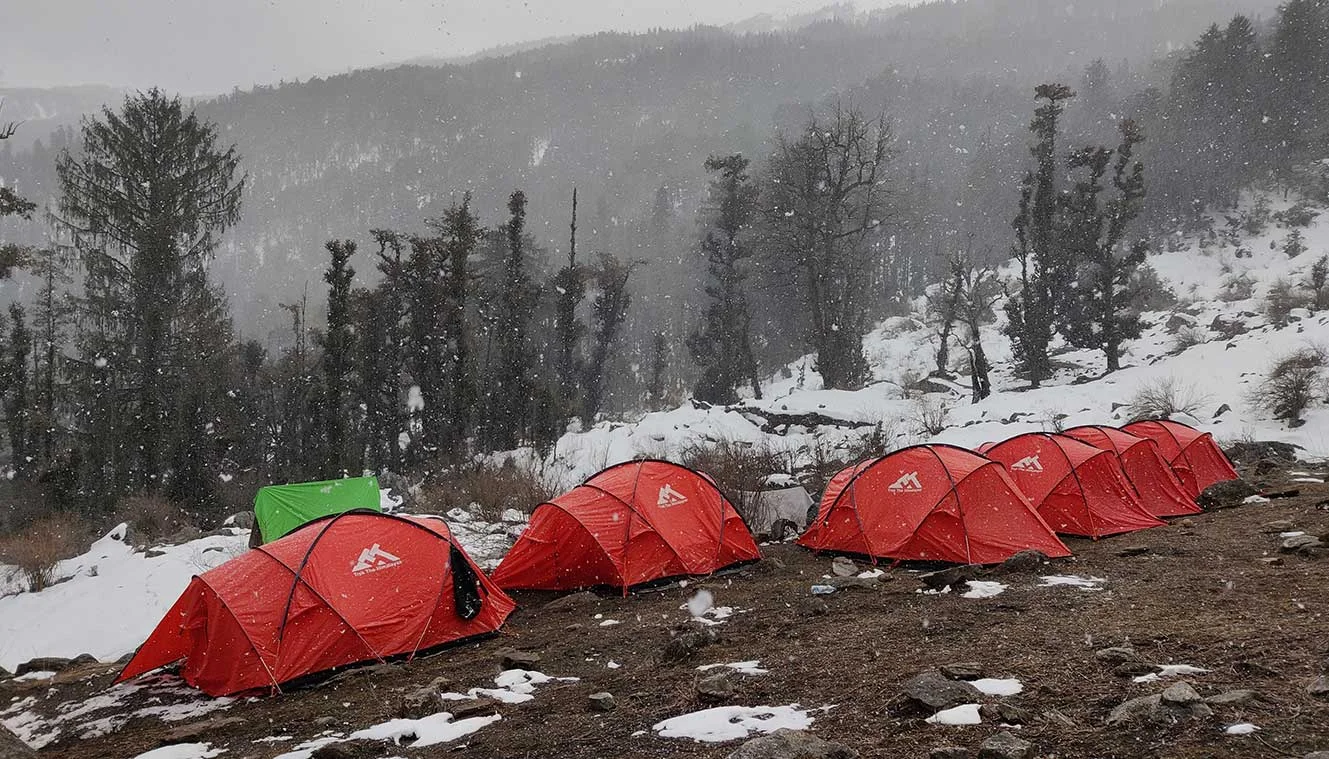
Gulling Top to Tali Forest Camp
Wake up in time next morning to start on a 5 hour journey deeper into the forest of Talli. After the exacting climb of last day, the trek today will be less arduous. The gradients of ascent is relatively smooth and will allow you an enjoyable hike.
Twenty minutes into the trek, you will come to a green clearing overlooking the magnificent snow peaks. After a few moments of rest, the climb must continue crossing a little stream to enter a mixed forest slowly thickening with oaks and rhododendrons. If you are coming in late March you might still find some white and pink blossoms. Except for rhododendrons, you can find walnut and some other varieties of conifers here.
At the height of winter’s splendour, you can find everything in the forest coated with a cover of snow. In the thickening snow, light, and shade of the conifer forests of Gulling, your second camp on the trek will be pitched.
Along this path, the Hathi-Ghori peaks will be manifesting gloriously along with Dronagiri now somewhat flipped to the side.
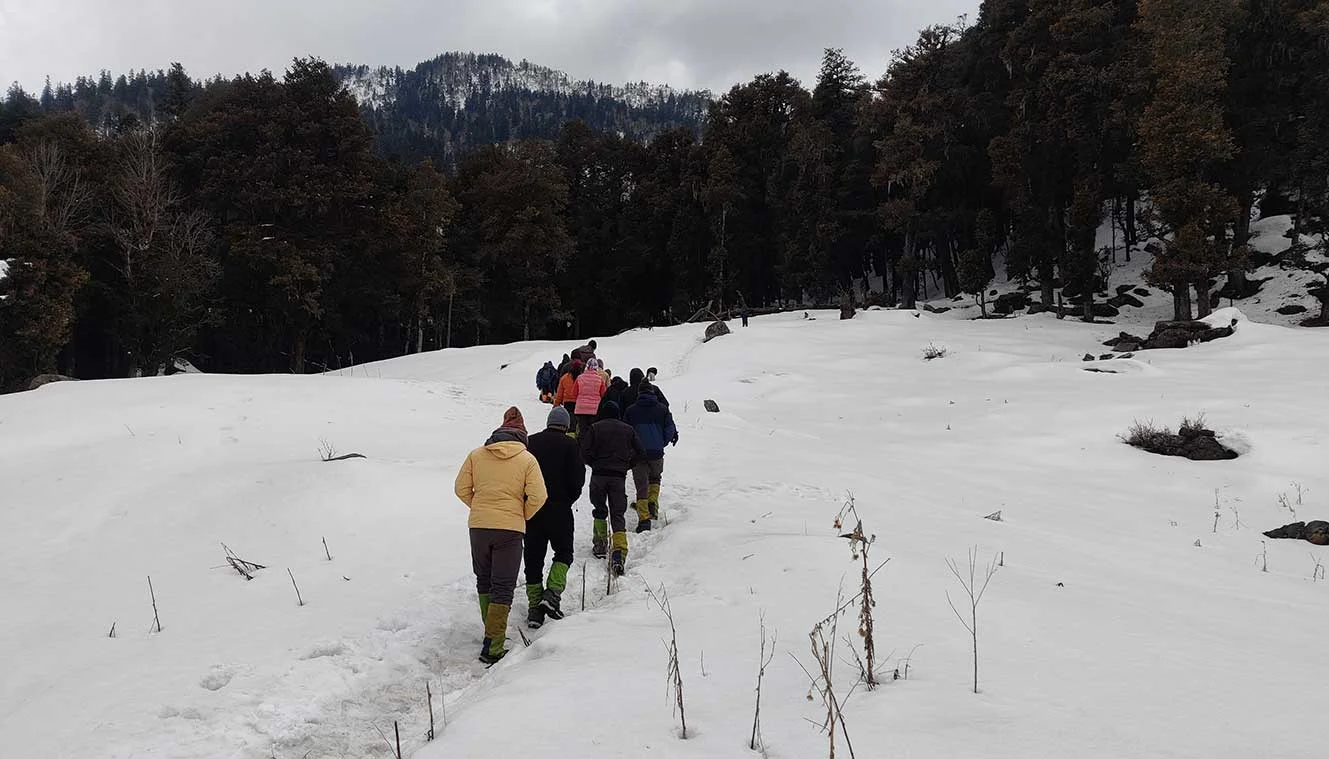
Tali forest camp to Kuari pass and back via Khullara top
Fourth day is the summit day, likely to span 10-11 hours depending on the group’s pace. You need to gear up appropriately for high snow and squalling wind on the ridges today. There is going to be no water source found on the way today,so carry enough to sustain you through.
In the first phase, the trek will move up to the Khullara top—a moderate ascent of 3.5 km. You will need to traverse a broken bridge and a stream frozen at the heights of winter, followed by a ridge climb to the high pass, severely strenuous and made more challenging with the snow. Every 15 minutes, you are welcome to take a break and catch your breath. At Jhandi Dhar, a suitable rest point 2 hours into the trek, you can afford a long break. Lunch will be had on the way or after reaching the temple at the base of the Kuari high pass.
Make sure to crampon your shoes properly. Trek the Himalayas will provide you good quality crampons and gaiters.
The climax of this trek comes with a visual bang exposing a host of Garhwal behemoth peaks, unveiling—Kedarnath Peak, Kedardome, Chaukhambha, Balakun, Neel Kantha, Mukut Parvat, Kamet, Abhi Gamin, Mana I, Ghori Parvat, Hathi Parvat, Dronagiri, Kalanka, Changabang, Nanda Devi, Nanda Ghunti.
The magnificence of this vision is incomparable.
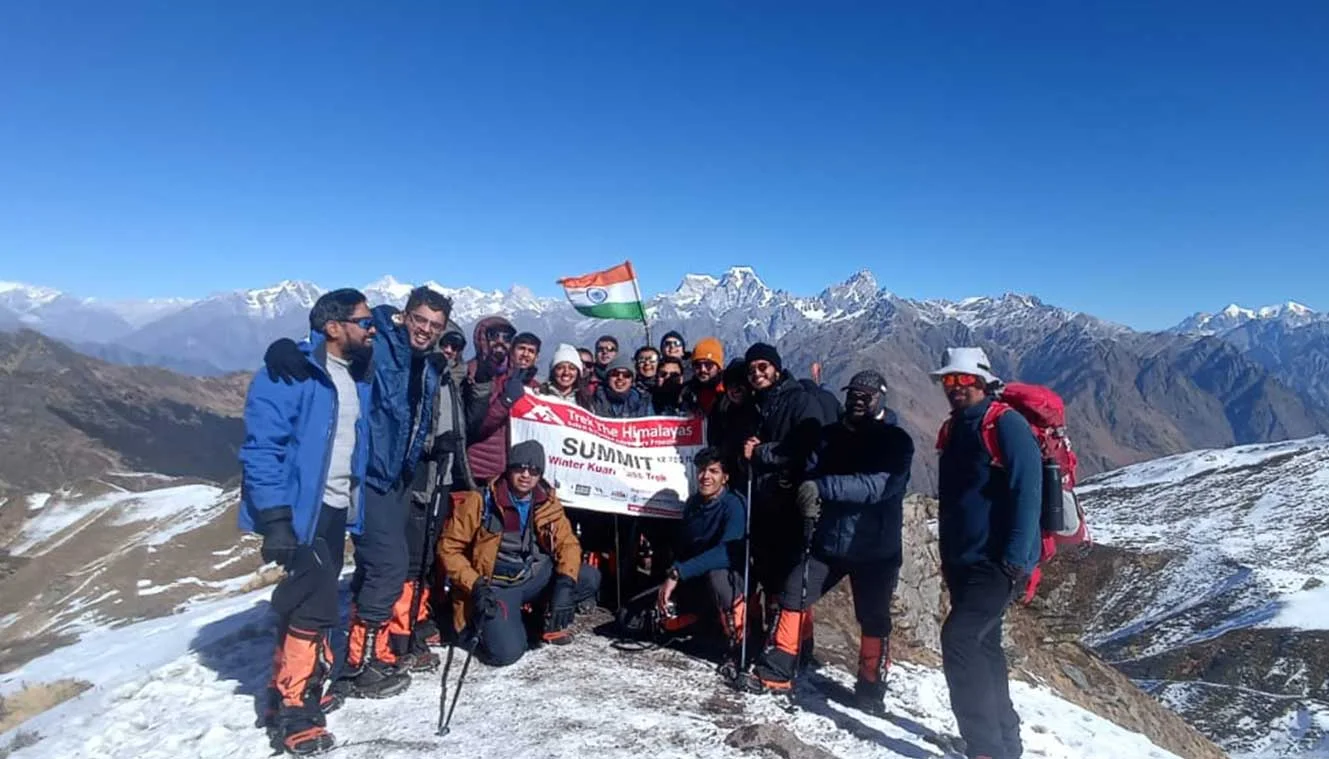
Tali forest camp - Pipalkoti via Gurson bugyal (11150 ft) and Auli (9680 ft)
Today we will advance towards Auli—the skiing capital of India, and one of the most famous in south Asia. Exploring the beautiful snow-patched rolling valleys of Gorson Bugyal, we will come down to Auli through a sweetly enjoyable journey.
Traversing the Bugyals of Gorson is completely free of any arduous and hassling climb, mainly on a smoothly rolling terrain, though the snow of high winter might leave the place a tad desolate. In the thaw season of March, skiing is a big activity here.
Please be advised that the cable car ride to Pipalkoti is not included in the trek package. However, trekkers have the option to experience the scenic cable car ride at their own expense upon reaching Auli. The cable car journey offers breathtaking vistas of the majestic ski resort, the gently sloping snow-covered slopes, and the captivating pine forests.
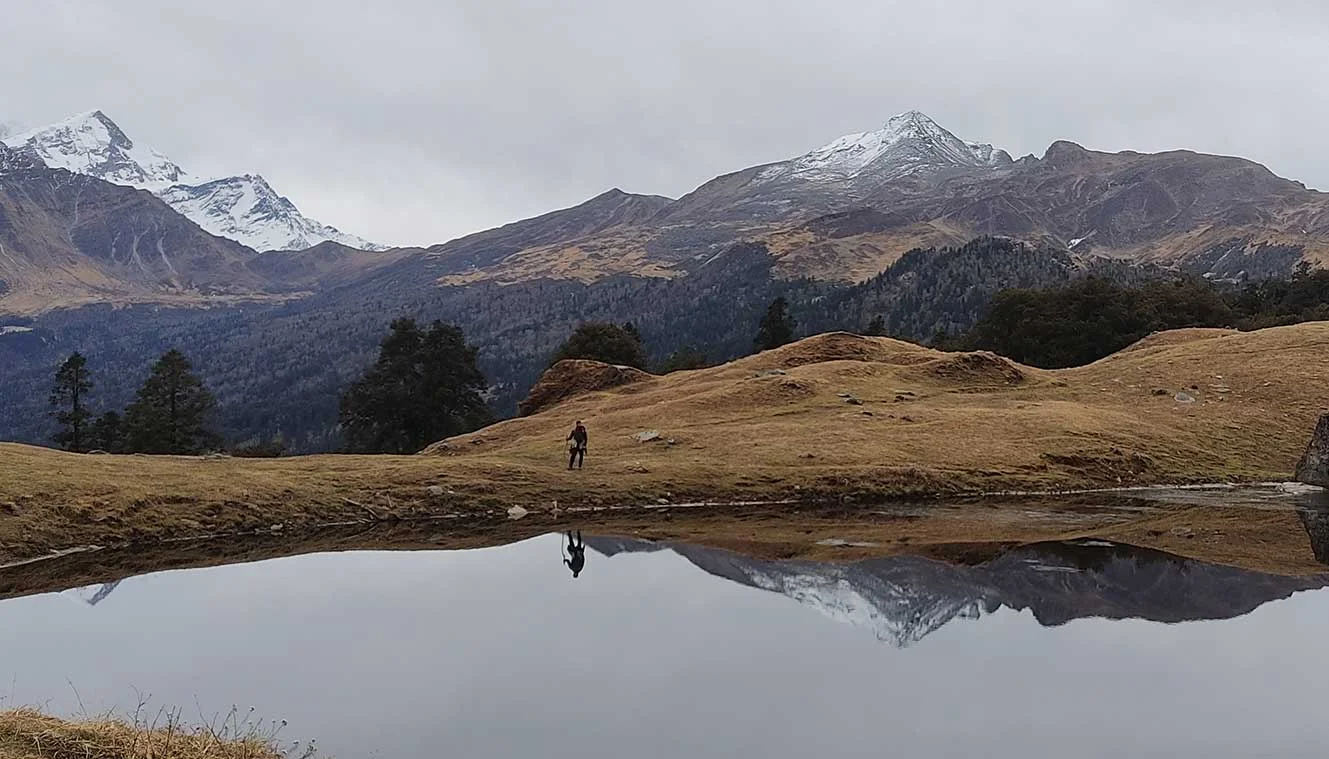

Pipalkoti To Rishikesh
Note: On Day 6, you’ll reach Rishikesh between 6 pm and 7 pm. You can book your travel any time after 8 pm.
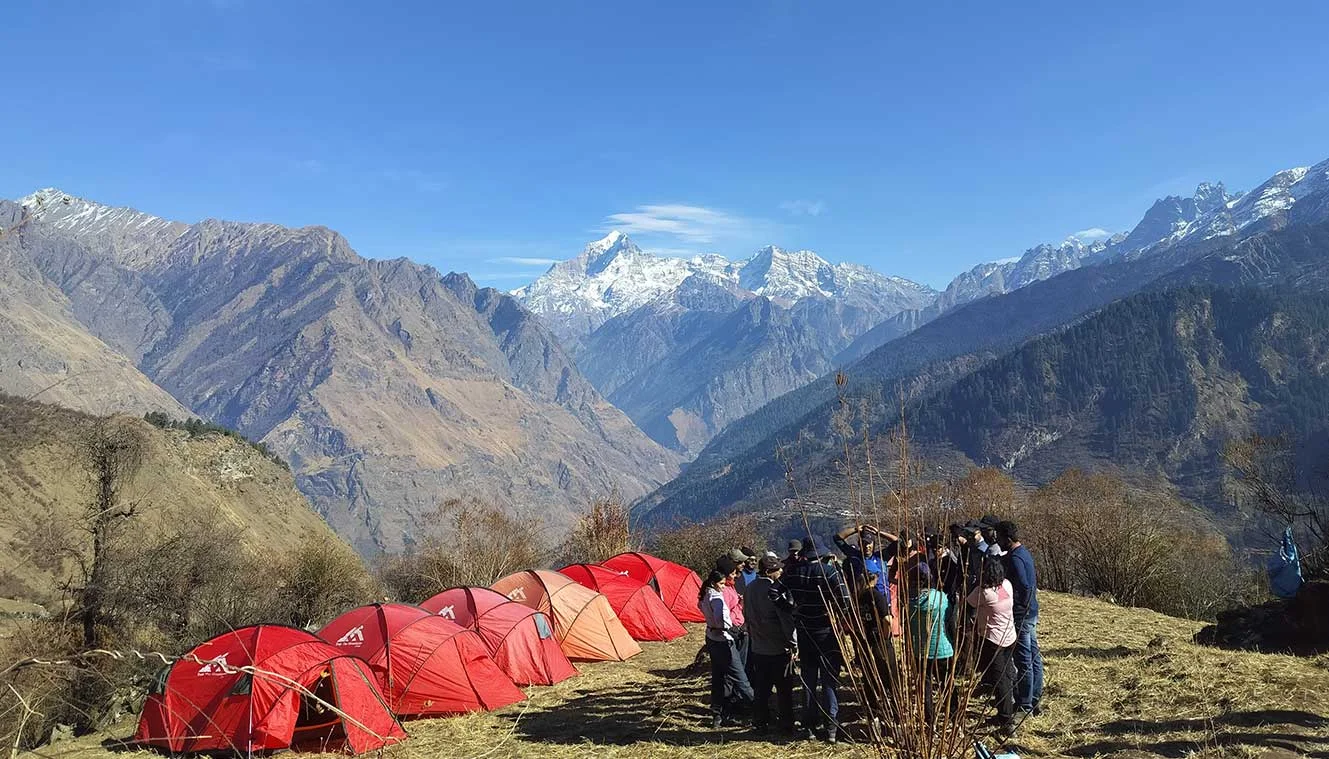
Day-1: Rishikesh to Pipalkoti
- Altitude: 1,500m/4,950ft.
- 200 km drive, approx 10 hours.
- Trekkers will be picked from Rishikesh TTH office at 6:00am in a Tata Sumo or a similar vehicle (cost is not included).
- Arrive at Pipalkoti approx by 5 pm – (tea, briefing of the trek & dinner).
- Breakfast and Lunch on the way (exclusive of charges).
- Accommodation at the guest house.
- Telephone Network- Available.
Note:
1 - Distance, Altitude and Trekking hours are approximate and rounded off.
2 - Keep the original and copy of ID proof handy.
3 - Please arrive one day early to ensure you reach the pickup point on time for your 6 am departure.
Day-2: Pipalkoti – Gulling Top
- Altitude: 2,750m/9,000ft.
- Drive from Pipalkoti to Tugashi village 50 km drive and Tugashi to Guilig Top 7 km trek, 4-5hrs.
- First 1 hour trek till road head.
- The trail is a mix of steep and gradual ascent, mostly through villages.
- Hot lunch at camp site.
- Water Points- Available at villages in passing.
- Accommodation in tent.
- Peaks spotted: Dronagri, HathiParvat, GoriParvat.
Day-3: Gulling Top to Tali Forest Camp
- Altitude :3,350m/ 11000 ft.
- Trek: 5 km ,approx 4 hrs.
- Altitude Gain: 600m/ 2,000ft.
- Gulling Top to Forest Hut (first and last water point) (3000m/9850 ft) (1 km trek).
- Forest hut to Tali top (Tali lake is there, steep ascent ) (3,500m/ 11500 ft) (2 km trek).
- Tali top to Tali top forest camp site (gradual descent) (3,400m/ 11,100 ft) (1 km trek).
- Oak, Rhododendron (mostly pink and white), walnut forest.
- Accommodation in tent.
- Peaks :- Nanda Devi, Kalanka, Chang bang, Dronagri, Hathi Parvat, Gori Parvat.
Day-4: Tali forest camp to Kuari pass and back via Khullara top
- Altitude: 3,800m/12,500 ft.
- Trek: 15 km, approx 11 hrs.
- Tali forest camp to Khullara top (moderate ascent) (3,600m/11,800 ft) (3.5 km trek).
- Khullara top to broken bridge with frozen stream (traverse walk) (3,750m/ 12,300 ft) (2.5 km trek).
- Broken bridge to KUARI PASS (Strenuous climb) (3,900m/ 12,750 ft) (1.5 km trek).
- Today is the toughest day.
- Carry enough water (no water source on the way).
- Early morning after breakfast start trek to Kuari pass.
- Peaks:- Kedarnath Peak, Kedardome, Chaukhambha, Balakun, Neel Kantha, Mukut Parvat, Kamet, Abhi Gamin, Mana I, Ghori Parvat, Hathi Parvat, Dronagiri, Kalanka, Chang Bang, Nanda Devi, Nanda Ghunti.
Day-5: Tali forest camp - Pipalkoti via Gurson bugyal (11150 ft) and Auli (9680 ft)
- Altitude:1,500m/ 4,950ft.
- Trek: 8 km, approx 7 hrs.
- Drive 13km, 25min.
- Tali forest camp to Tali lake (3,500m/ 11,500ft) (1 km trek).
- Tali lake to Gurson bugyal (3,400m/ 11,150 ft) (3.5 km trek).
- Gurson bugyal to Auli (2,950m/ 9,700 ft) (3.5 km trek).
- Auli to Pipalkoti (1,500m/ 4,950ft) (45 km drive).
- Breakfast at Tali camp site.
- Lunch Pack on the way.
- Pipalkoti (evening tea, debriefing, dinner).
Note: If weather and route condition will be fine and safe then only we will descend through Gurson Bugyal and Auli otherwise, we will descend through Gulling Top to Tugashi.
Day-6: Pipalkoti To Rishikesh
- Drive: 200 km, approx 9 hrs.
- Ride will commence at 6 am, reaching destination at around 6 pm.
- Breakfast and Lunch will be on the way at a roadside inn, exclusive of charges.
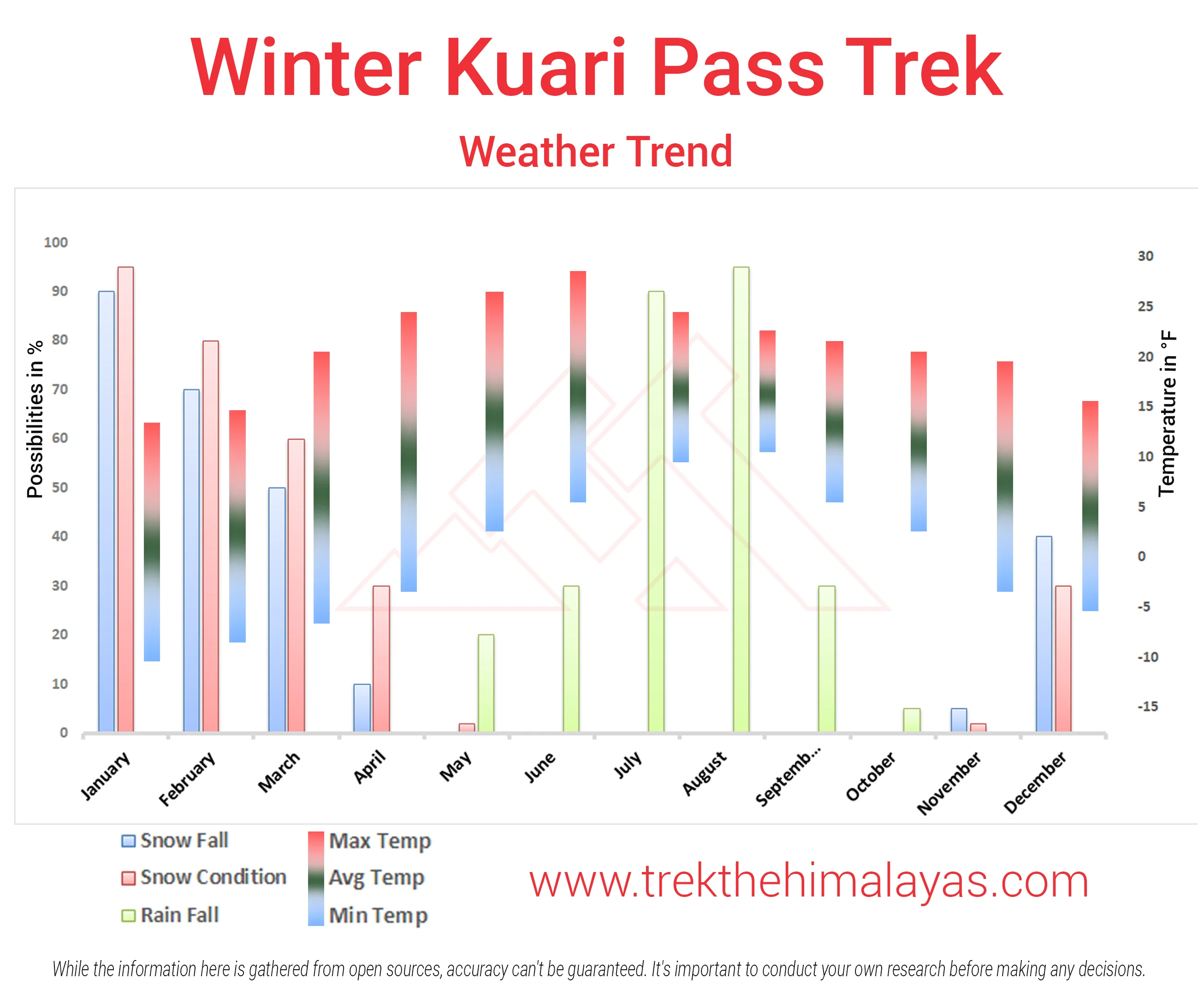
Important Links
- Mandatory Documents to Bring on A Trek Click Here.
How To Reach
It is essential for everyone to arrive at Rishikesh (06:00 am)
Trek The Himalayas Head office, Tapovan Laxmanjhula, Landmark -Nainital Bank opposite Shiv Vilas Hotel
Once you have reached Rishikesh, TTH will manage the rest of your travel arrangements, if you have opted for TTH's pick-up service, you can select this option during the booking process by adding it as an add-on.
Options to reach Rishikesh
- Take overnight train/bus to Rishikesh.
- Take overnight train/bus to Haridwar and drive to Rishikesh (35 min drive with normal traffic).
We always recommend going for the govt. Buses over the private ones outside the bus station as based on the experience we have found that there are very high chances of delay involved with private buses. Also, govt. Buses are always more reliable. Whichever bus you choose, just make sure to reach Rishikesh at least by 05:30 am.
3. Board a flight to Dehradun airport (Jolly Grant Airport) (21 km, 30 min). If you're arriving by air, then come one day in advance.
If you prefer to travel independently to Base camp and don't want to take TTH's pick-up service, you can either take a government bus or book a private cab from Rishikesh. Your trek coordinator will provide guidance on how to arrange for the bus or cab booking.
Arrive in Rishikesh by 3:00 to 4:00 pm.
The designated drop-off point is Trek The Himalayas Office (Tapovan | Laxmanjhula).
Please consider planning your subsequent travel arrangements after 7:00 pm.
TTH offers comfortable transportation through Tempo Traveler, Bolero, or equivalent vehicles. If you wish to upgrade your mode of transportation, please contact your trek coordinator for further assistance.
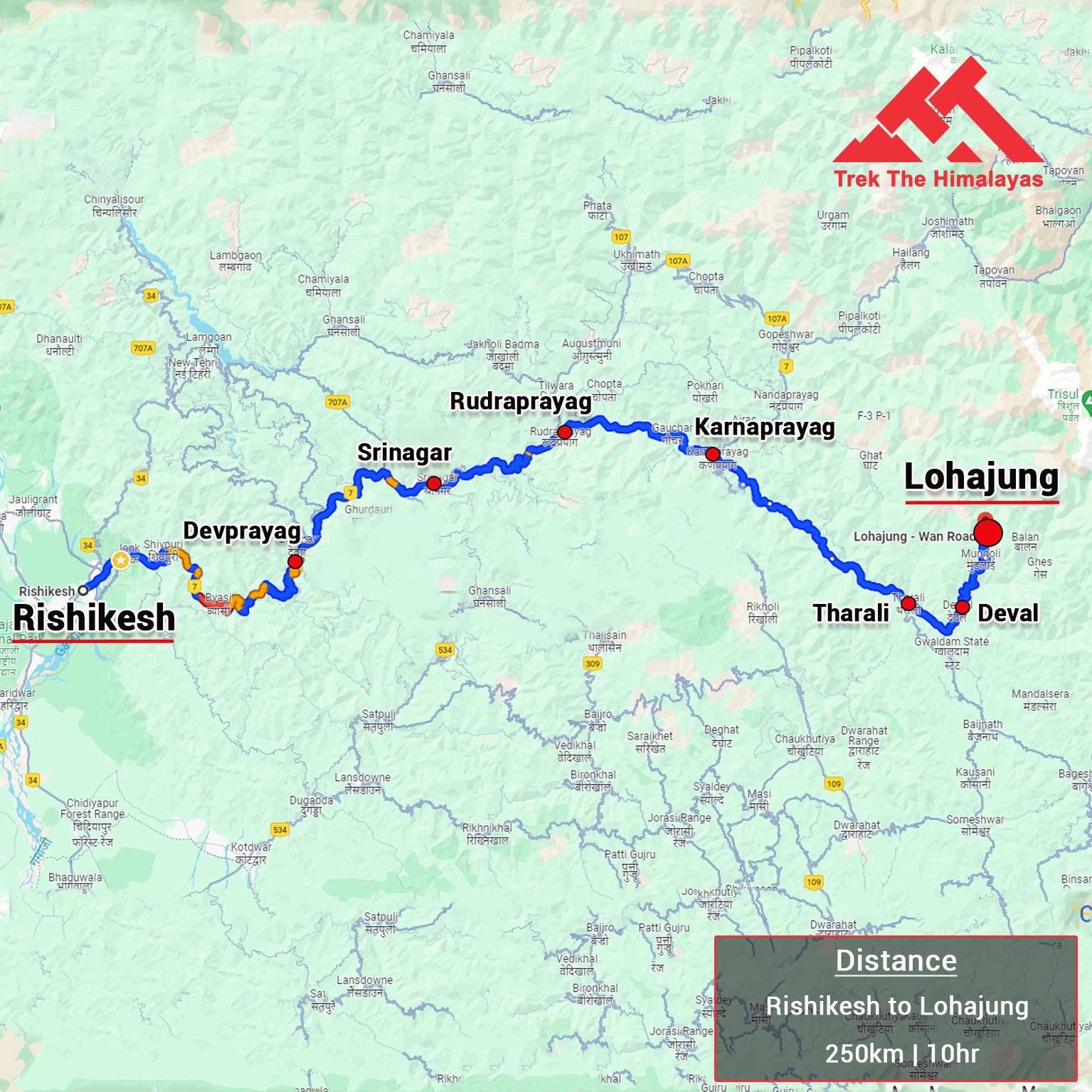
Cost Terms
Inclusion
1. Accommodation (as per the itinerary):
- Guest house in Pipalkoti (Day 1 and Day 5 as per the itinerary).
- Camping while on trek (twin sharing).
2. Meals (Veg + Egg):
- All meals (including tea, soup, snacks etc.) from Day 1 Dinner to day 5 dinner.
3. Support:
- 1 Versatile base camp manager: handles communication and deploys extra manpower in emergencies.
- 1 Mountaineering & First aid qualified professional trek Leader.
- 1 Experienced high altitude chef.
- Local experienced guides (Number of guides depending on the group size).
- Enough support staff.
4. Trek equipment:
- Sleeping bag, Sleeping liners (if required), Mattress, Utensils.
- 3 men all season trekker tent (twin sharing), Kitchen & Dining tent, Toilet tent.
- Camping stool, Walkie talkie.
- Ropes, Helmet, Ice axe, Harness, Gaiters & Crampon (if required).
5. First aid:
- Medical kit, Stretcher, Oxygen cylinder, Blood pressure monitor, Oximeter, Stethoscope.
6. Transportation (as per the itinerary):
- Transport from Rishikesh to Pipalkoti and back ( As per the itinerary).
7. Mules/porters to carry the central luggage.
8. Clock room facility available at the base camp for additional luggage
9. All necessary permits and entry fees, Upto the amount charged for Indian
10. Trek Completion Certificate.
Exclusion
- Insurance (Mandatory).
- Food during the transit.
- Any kind of personal expenses.
- Mule or porter to carry personal luggage.
- Emergency evacuation, hospitalization charge or etc.
- Anything not specifically mentioned under the head Inclusion.
Things can be provided on demand and availability (participant has to pay extra for these things).
1- Satellite phone/set phone - is a type of mobile phone that connects via radio links via satellites orbiting the Earth instead of terrestrial cell sites like cellphones. Therefore, they can operate in most geographic locations on the Earth's surface.
2- Gamow/PAC HAPO Bag (Portable Hyperbaric Bag) - is a unique, portable hyperbaric chamber for the treatment of acute mountain sickness (AMS), also known as altitude sickness.
3- AEDs (Automated External Defibrillators) - are portable life-saving devices designed to treat people experiencing sudden cardiac arrest, a medical condition in which the heart stops beating suddenly and unexpectedly.
Cancellation terms:
Cancellations prior to 25 days from the start of the Trip
Refund options
- 5% deduction of trek fee
- 100% cash voucher for any trip till one year
- Transfer your trek (any trek, any date) to your friend
Cancellation between 24 days and 15 days to the start of the Trip
Refund options
- 30% deduction of trek fee
- 100% cash voucher for same trip till one year
- 85% cash voucher for any trip till one year
- Transfer your trek (same trek, any date) to your friend
Cancellation between 14 days and 10 days to the start of the Trip
Refund options
- 50% deduction of trek fee
- 80% cash voucher for same trip till one year
- 70% cash voucher for any trip till one year
- Book the same trek, in the same season, with any other batch
- Transfer your trek (same trek, any date) to your friend
Cancellation less than 9 days to the start of the trek
Refund options
- No cash refund
- 20% cash voucher for the same trip till one year
- 10% cash voucher for any trip till one year
- Transfer your trek (same trek, same date) to your friend
Note- If a booking is made using a voucher or discount code, the policies related to vouchers and discounts cannot be modified.
In the unlikely event that TTH cancels a trek prior to the scheduled departure date:
While it is extremely rare for TTH to cancel a trek, we understand that unforeseen circumstances or natural disasters may occasionally require us to do so before the scheduled departure. These circumstances could include continuous rain or snow, thunderstorms, snowstorms, landslides, floods, earthquakes, or any other natural calamity that poses a risk to the safety of our trekkers. Additionally, unforeseeable events such as local riots, curfews, pandemics, lockdowns, government orders, or any similar situations that compromise the safety of the trekking experience may also necessitate a cancellation.
In the event of such a cancellation, TTH will provide you with a voucher equivalent to the amount you paid for the trek. This voucher can be redeemed for any of our treks within the next year, allowing you to still enjoy an adventure with us at a later date.
Note
-
The issuance of a voucher is not applicable in situations where you are required to descend from the trek for any reason. The trek leader may make the decision to send you down from the trek due to factors such as insufficient fitness level, symptoms of Acute Mountain Sickness (AMS), high blood pressure, exceeding the designated turn-around-time, health concerns, or if you are found smoking, drinking, or violating the rules set for the trek. In such cases, the provision of a voucher does not apply.
In the rare event that TTH shifts a trek:
We would like to emphasize that weather conditions in high-altitude areas are highly unpredictable and can undergo sudden changes at any time, irrespective of the day. Additionally, circumstances beyond our control, such as natural disasters, political unrest, pandemics, and lockdowns, may impact the feasibility of conducting a trek. In cases where we are unable to proceed with an event due to such circumstances that are beyond our direct control, we will make every effort to provide you with an alternative trek that is safer and more suitable.
In such situations, we will issue a voucher to offset the cost difference between the originally scheduled trek and the alternative trek. This voucher can be redeemed at any time within one year from the date of issue. Please note that a refund fee or reimbursement of the cost difference is not applicable in these cases.
Note:
- Change of trek batch is dependent on the availability of seats in the batch
- In case of transferring a trek to a friend, he/she should satisfy all the mandatory requirements put forward by TTH
- TTH holds the right to change/cancel the policies, without prior notice
- Cash refund is applicable only in case of bookings made without using any promotional offer code or vouchers
Cash Voucher Terms:
- This is a non-transferable voucher
- The voucher cannot be merged with any other offer of Trek The Himalayas
- The voucher is valid for Trek booked directly with Trek The Himalayas in India
- To avail the voucher please use your register phone number or e-mail id
- All the other Terms of booking a trek with Trek The Himalayas are applicable to the voucher
- Trek The Himalayas holds rights to add/remove any of the Terms and Conditions without prior notice
Itineraries are based on information available at the time of planning and are subject to change. "Trek The Himalayas" reserves the right to change expedition dates, people or itineraries as conditions warrant. If a trip must be delayed or the itinerary changed due to bad weather, road conditions, transportation delays, government intervention, airline schedules, sickness, or other contingency for which TTH or its agents cannot make provision, the cost of delays and/or other changes are the responsibility of the participant. TTH reserves the right to decline, or accept, any individual as a trip member for any reason whatsoever.
Trek Essentials
PDF Of Trek Essential Download
| Backpack with rain cover | (50 - 60 ltr) with comfortable shoulder straps |
| Day pack with rain cover | 20 - 30 ltr (If off-load opted) |
| Walking stick | Advisable (At least one) |
| Water Bottle / Hydration pack | 2 thermos flask bottles of one liter each, Avoid hydration pack. |
| Small size tiffin/lunch box | 1 Nos |
| Snacks | Energy bars, dry fruits, electoral/ors |
| Personal Medical Kit | Consult your doctor |
| T-Shirt (Synthetic quick dry) | 1 Full & 1 Half sleeves |
| Fleece T-shirt | 2 Nos |
| Wind stopper / Fleece jacket | 1 Nos |
| Windproof Jacket | 1 Nos |
| Down feather / Hollow jacket | 1 Nos. |
| Thermal inner (Upper and Lower) | 1 Pair |
| Trek Pant (Synthetic quick dry) | 1 Nos. |
| Wind stopper / Fleece Pant | 1 Nos |
| Waterproof gloves | 1 Pair |
| Fleece / woollen gloves | 1 Pair |
| Poncho / waterproof Jacket and pant | 1 Nos. |
| Sunscreen | 1 Nos. |
| Moisturiser | 1 Nos. |
| Chap-stick / Lip balm | 1 Nos. |
| Toothbrush and toothpaste | 1 Nos. |
| Toilet paper & Wipes | 1 Nos. |
| Hand sanitizers | 1 Nos. |
| Antibacterial powder | 1 Nos. |
| Quick dry towel | 1 Nos. |
| Head torch | 1 Nos. (Avoid Hand torch) |
| Sun Cap | Not required |
| Woolen cap | 1 Nos. |
| Balaclava | 1 Nos. |
| Buff / Neck-gaiters | 2 Woollen |
| Sunglasses | UV with dark side cover, People who wear spectacles - (A)- Use contact lenses | (B)- Photo chromatic glasses |
| Trekking shoes | 1 Pair (Waterproof, high ankle, good grip) |
| Floaters / flip-flops | Not required |
| Cotton socks | 4 pairs |
| Woollen socks | 3 pairs |
| Gaiters | 1 Pair (TTH provides when required) |
| Micro spikes | 1 Pair (TTH provides when required) |
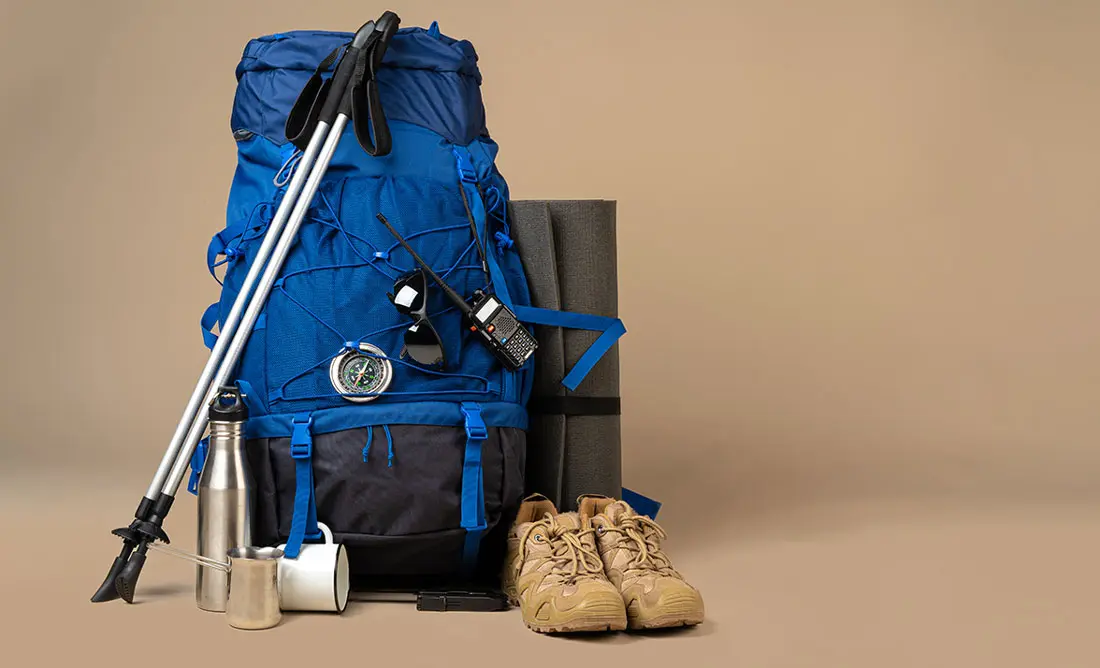
Frequently Asked Questions(FAQ)
To register with TTH, visit our website - www.trekthehimalayas.com and create your account. To create your account you will need to use your email address and fill in all the details, set your unique password and your account is ready to use.
- To book a trek with TTH, you first need to register with us and create an account.
- Choose the trek that you want to do and click on available dates.
- You will land at the login page, fill in the required details.
- Add Participants, choose add-on services click on the Pay now button, choose your preferred payment method, and make the payment. TTH accepts multiple payment options, including credit/debit cards, net banking, and UPI.
- You will receive a confirmation email from TTH with all the necessary details about the trek, including the meeting point, transportation, accommodation, and other important instructions.
please send an email to us at info@trekthehimalayas.com or reach out to the numbers provided in the Help and Support section of your Trek Page. We will ensure that your issue is promptly resolved.
To book services such as off-load luggage and transportation, you can find them listed as add-ons. These additional services can be booked at the time of your initial booking. If you miss booking add-ons during the initial reservation, you can log in anytime and easily book 4 days before the departure date add-ons through the platform.
In such a situation, please log in to your account and transfer your trek or date to the desired one within 12 hours or drop us an email at info@trekthehimalayas.com 10 days before the departure date of the trek. After the initial 12-hour period, any changes will be processed according to the cancellation policy.
We recommend visiting our "Suggest Me a Trek" page. By filling out the form, our experts will contact you with the best possible trek options based on your preferences and experience level. Alternatively, you can reach out to us via email at info@trekthehimalayas.com or give us a call using the numbers provided on our website for personalized assistance and recommendations.
Family treks differ from regular treks by focusing on ease of difficulty, offering shorter durations for younger participants, Kid-friendly and easily digestible foods, child-friendly activities, maintaining a higher guide ratio for diverse age groups, and implementing additional safety measures for families.
Family Trek with Kids recommendation Only Dayara Bugyal and Chopta Chandrashila Trek.
Minimum age for TTH treks is typically 7 years, though this may vary depending on the specific trek.
Yes, you can take a kids to a high-altitude trek with a parent. Discuss with a trek expert before booking a trek.
Junior trekkers (below 15 years) should have a company of parents/guardians.
Trekkers between 15 to 18 years can come solo with the disclaimer form signed by parent/guardian.
Medical & Disclaimer Form (Mandatory Documents) Click here to download medical and disclaimer form
Physical Fitness: Ensure your child is physically fit. Engage them in regular exercise, outdoor activities, and hikes to build stamina and endurance. Hydration: Emphasize the importance of staying hydrated at high altitudes. Encourage your child to drink water regularly, even if they don't feel thirsty. Proper Nutrition: Provide a well-balanced diet with sufficient carbohydrates for energy and foods rich in iron to prevent altitude sickness. Adequate Sleep: Ensure your child gets enough sleep in the days leading up to the trek. Quality rest is crucial for altitude adaptation. Educate on Altitude Sickness: Teach your child about the symptoms of altitude sickness, such as headache, nausea, and dizziness. Encourage them to communicate any discomfort immediately. Appropriate Clothing and Gear: Dress your child in layers to adjust to changing temperatures. Ensure they have appropriate trekking gear, including sturdy footwear. Positive Mindset: Foster a positive mindset. Encourage your child, and let them know it's okay to take breaks when needed. Medical Check-Up: Schedule a medical check-up before the trek to ensure your child is fit for high-altitude activities. Consult with a healthcare professional about any potential health concerns.
TTH takes special care to provide wholesome and nutritious food for children on treks. Here are some of the foods that are typically served for children:
Breakfast: For breakfast, TTH serves a variety of options like porridge, cornflakes, bread, butter, jam, honey, boiled eggs, omelettes, and pancakes. Children can choose from these options to fuel themselves for the day's trek.
Lunch: For lunch, TTH serves lunch which includes rotis, vegetables, rice, dal, and salad. The rotis are usually made fresh on the trek and are a good source of carbohydrates. The dal and vegetables provide protein and other essential nutrients.
Snacks: TTH provides healthy snacks like fresh fruits, dry fruits, energy bars, cookies, and biscuits to keep the children energized throughout the day.
Dinner: For dinner, TTH serves a hot and wholesome meal which includes soup, rice, dal, vegetables, and a non-vegetarian dish (if requested in advance). Children can also choose from a variety of desserts like custard, jelly, and fruit salad.
Dietary requirements: If a child has any special dietary requirements, TTH can cater to those needs as well. For example, if a child is lactose intolerant or allergic to nuts, the kitchen staff can make arrangements to accommodate those requirements.
Choosing the right trek for a beginner can be a bit overwhelming as there are many factors to consider such as distance, elevation gain, terrain difficulty, weather, and time of year. Here are some tips that can help you choose the right trek for a beginner:
1. Determine fitness level: Assess the fitness level of the beginner to understand their physical capabilities. This will help you select a trek that is challenging but not too difficult.
2. Choose a well-traveled trail: A well-traveled trail will have more amenities such as signposts, water stations, and shelter. It is also safer as there will be other hikers on the trail.
3. Consider the length of the trek: For beginners, it is recommended to start with a shorter trek that can be completed in a day or two. This will help them get acclimatized to trekking and build their confidence.
4. Look for gradual elevation gain: Choose a trek with a gradual elevation gain rather than steep ascents. This will make the trek easier and more enjoyable.
5. Check the weather: Check the weather forecast before selecting a trek. Avoid treks during the monsoon season or winter when the trails can be slippery or dangerous.
6. Research the trail: Read about the trail to get an idea of the terrain, altitude, and difficulty level. This will help you select a trek that is suitable for the beginner.
7. Consult with an expert: If you are unsure about which trek to choose, consult our trek expert Mr. Nitin (+91 70600 59773) between 10 AM to 6 PM (Tuesday - Friday). Mr. Nitin will provide you valuable advice and guidance.
Overall, it is important to choose a trek that is enjoyable, challenging but not too difficult, and suitable for the beginner's fitness level and experience.
It is not recommended for a beginner to choose a difficult Himalayan trek. Trekking in the Himalayas can be physically and mentally challenging, especially if you are not used to the high altitude, steep slopes, and rugged terrain. Choosing a difficult trek without the proper experience, fitness level, and preparation can be dangerous and put you at risk of altitude sickness, injury, and other hazards.
If you are a beginner, it is recommended to start with an easier trek and gradually build up your skills and experience. This will help you understand the challenges of trekking in the Himalayas, and also prepare you physically and mentally for a more difficult trek in the future. It is also important to choose a trek that matches your fitness level, experience, and interest.
There is no specific age limit for a beginner trekker. However, it is important to consider your physical fitness, health condition, and personal interests before embarking on a trek. Trekking in the Himalayas can be physically and mentally demanding, and requires a certain level of physical fitness and endurance.
If you have any pre-existing medical conditions or are above a certain age, it is recommended to consult with a doctor before embarking on a trek. It is also important to listen to your body and take breaks as needed during the trek to prevent exhaustion or injury.
We recommend visiting our "Suggest Me a Trek" page. By filling out the form, our experts will contact you with the best possible trek options based on your preferences and experience level. Alternatively, you can reach out to us via email at info@trekthehimalayas.com or give us a call using the numbers provided on our website for personalized assistance and recommendations.
Yes, you can join the trek. We have fixed departure groups where you can simply book your trek and we will take care of curating a group.
Before you start the trek, it is recommended that you make all the necessary phone calls as during the trek you may or may not receive network coverage, once you come back to the Base Camp, you can reconnect with your family via phone once again. You can share your trek coordinator contact detail with your family members to get the latest updates about your trek batch.
At TTH, we provide wholesome and nutritious meals during the trek. The food is vegetarian and includes a variety of dishes such as rice, dal, vegetables, chapati, paratha, pasta, noodles, and soup. We also offer snacks such as biscuits, and salty, and dry fruits during the trek. Special dietary requirements such as vegan, gluten-free, or Jain food can also be arranged if informed in advance.
If you are allergic to some foods, you need to let us know in advance so that we can make arrangements accordingly.
TTH is a trekking company that prioritizes the safety of all its participants, including women trekkers. They have a comprehensive safety system in place, which includes a dedicated team of experienced and trained trek leaders and support staff who are equipped to handle emergency situations and provide first aid.
TTH also takes specific measures to ensure the safety and comfort of women trekkers. They have a separate tent accommodation for women trekkers, female trek leaders, and support staff. They also provide separate toilet facilities for women and encourage a safe and respectful environment for all trekkers.
Moreover, TTH has a strict policy against any kind of harassment and has a zero-tolerance policy towards such incidents. They have a designated Internal Complaints Committee (ICC) to investigate and address any complaints related to harassment or misconduct. Overall, TTH has a good reputation for safety and responsible trekking practices, and women can feel comfortable and safe while trekking with them.
In case you are the only women in the group, we provide a single sleeping arrangement. Also, during the trek, the trek leader will always remain by your side to provide optimum safety and reassurance.
You can reach out to the trek coordinator to inquire about the number of female trekkers and their respective states who have booked the trek. Please note that the trek coordinator cannot disclose personal details of any trekker. Once you've confirmed your booking, a WhatsApp Group will be created for all the trekkers in your batch. This allows you to connect with fellow trekkers before the trek begins.
While many of our treks are led by female trek leaders, however, it is not possible to know which trek leader is assigned to which group. But nonetheless, whether the trek leader is male or female you can be completely assured of your safety and security with us.
Yes, it is possible to trek with periods. However, it is important to take some extra precautions and preparations to ensure a comfortable and safe trekking experience.
Here are some tips that can help you trek during your period:
1. Use menstrual hygiene products that you are comfortable with, such as tampons, pads, or menstrual cups. It is recommended to carry enough supplies for the entire duration of the trek.
2. Pack wet wipes, hand sanitizer, and plastic bags to dispose of used hygiene products.
3. Wear comfortable and breathable clothing that allows for easy movement and reduces friction. Avoid wearing tight or restrictive clothing that can cause discomfort.
4. Carry pain relief medication, such as ibuprofen or acetaminophen, in case of menstrual cramps.
5. Stay hydrated and maintain a balanced diet to support your energy levels and overall health.
6. Take breaks as needed and listen to your body. If you feel uncomfortable or experience any unusual symptoms, seek medical attention immediately.
It is also recommended to consult with a doctor before going on a trek during your period, especially if you have a pre-existing medical condition or are taking medication. By taking necessary precautions and being prepared, you can have a safe and comfortable trekking experience even during your period.
We provide proper disposal facilities for sanitary pad disposal during the trek.
We offer three person tents with twin-sharing for optimum comfort. A woman trekker will share a tent with another woman trekker and if you are the only woman in the group, you will be given a single accommodation for your comfort and privacy.
Yes, we do provide gears on rent. You can book it using you TTH account directly.
Mountaineering qualified Experienced and first aid certified Trek Leader, First Aid Certify local guide, Cook, helpers and supporting staff.
People suffering from Bronchitis, Asthma, High blood pressure, Epilepsy (got faints), TB , Heart problem or on higher BMI side are strictly not allowed to go on any Himalayan trek. Apart from this if you had any medical history, please let us know.
No. Alcohol and smocking isn’t allowed while on trek. It is totally misconception that it will keep you warm. Your body need to acclimatize properly and for that eat properly and drink enough water; these things will keep you warm.
Toilet tents provide a convenient solution for answering nature's call in the great outdoors. Dry toilets, in particular, offer a highly sanitary approach. By digging a pit and utilizing mud and a shovel, you can easily cover up your waste. This method ensures cleanliness and hygiene while camping or exploring in the forest.
Remember to pack essential toiletries to complete your outdoor bathroom kit and maintain proper personal hygiene during your adventures. With these practices in place, you can enjoy nature while also respecting it.
Layer Up From Head To Toe
Eat Full Meals, never sleep empty stomach
You can keep warmee (if you’re more susceptible to cold).
Use sleeping bag in right way and don’t leave free space in sleeping bag.
For upper body
– Thermal layer
– T-shirt (full-sleeves)
– Fleece T-shirt (for extreme colds)
– Fleece layer
– Thick Jacket/Down Jacket
– Waterproof or Windproof layer (outermost layer, when it is snowing or raining)
- For Lower Body
– Thermal layer
– Hiking pants (normal) or Winter hiking pants
Based on how warm you feel you can skip any of the above layers. Your outer later should be windproof since it is windy at high altitude.
The idea behind layering is that the more insulation you have the less cold you feel, and instead of wearing a very thick jacket if you wear multiple layers, your body will be better insulated against the cold.
Yes, we provide micro spikes and gaiters, if required.
Mandatory documents: 2 xerox of ID having address (addhar card/driving license), 2 Passport size photographs, hard copy Medical form signed & sealed by doctor, disclaimer form sign by trekker and high altitude insurance.
No. We don’t but we can suggest you good hotel/Stay nearby pick up location.
Yes, trekker must carry 2 water bottles 1 litre each so they can refill it at campsite for drinking and keep themselves hydrate.
You should buy shoes which has these three features –Good grip, Ankle Support and additional water resistant layers. Generally, we advise Quechua Trek 100, MH 500 and MH 100.
Your return transport is also included in trek fee if you're opting for service Dehradun to Dehradun ; we use Tempo Traveller/ Tata Sumo/Max/Boloero kind of vehicle.
No one is forced to go on. There is always enough staff to split the party according to need and regroup later at the camp. Most people have no trouble reaching the highest campsite. If some members decide not to climb the final distance they can wait for the climbers to come back down the same way or take a lateral path to the descent route.
We always have a first aid kit close at hand. Serious injuries are rare. Porters will assist injured climbers to the base of the mountain and onward to a clinic or hospital. Kilimanjaro International Airport is very near Marangu Gate if evacuation to the US or Europe is advisable.
Winter Kuari Pass, a breathtaking slice of paradise nestled in the heart of the Indian Himalayas, beckons adventurous souls with its ethereal beauty and enchanting allure. As the snow-covered trails wind their way through dense forests and pristine meadows, nature's masterpiece unfolds before your very eyes. The towering peaks stand tall, their majestic presence inspiring a sense of awe and wonder. The crisp, cold air fills your lungs, invigorating your spirit as you embark on this unforgettable journey. Each step brings you closer to the summit, where a panoramic vista of snow-clad mountains embraces you, leaving you spellbound. The serenity and solitude of this winter wonderland create the perfect canvas for self-reflection and introspection, allowing you to connect with the raw power of nature.
It takes 6 days to complete the Winter Kuari Pass Trek.
Winter Kuari Pass Trek is a 33 km trek.
Winter Kuari Pass Trek is a moderate-grade trek.
The best time to do Winter Kuari Pass Trek is winter (Mid-Nov - Mid-Feb) and Spring (Mid-Feb - Mid-Apr).
The maximum altitude reached during the Winter Kuari Pass Trek is 12,750 ft.
Here are some of the essential items that you should bring for the trek:
1. Mountaineering Boots: Sturdy, waterproof boots with good ankle support and crampon compatibility are a must.
2. Warm Clothing: This includes a warm-down jacket, thermal inner layers, and waterproof outer layers.
3. Backpack: A durable backpack to carry your equipment and personal items.
4. Sunglasses: To protect your eyes from harmful UV rays and snow glare.
5. Gloves: Waterproof and warm gloves that provide dexterity and grip.
6. Headlamp: A powerful headlamp with extra batteries for se during early morning starts or late night hikes.
The Winter Kuari Pass Trek falls under the jurisdiction of the Forest Department and as such it is necessary to obtain Forest Permit for the trek. When you trek with us, we obtain the permit ourselves.
Yes, it is safe to do the Winter Kuari Pass Trek with an expert organization. However, it is always advisable to take necessary precautions and follow safety guidelines issued by the Trek Leaders and guide while trekking in the mountains.
On the Winter Kuari Pass Trek, you will be camping in different campsites. We provide twin-sharing tents for optimum comfort.
